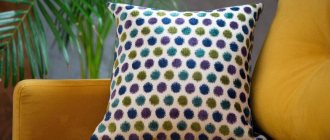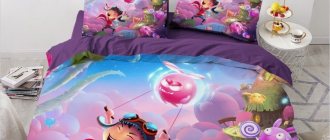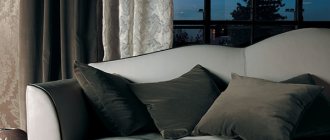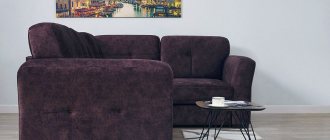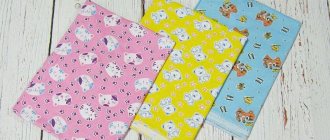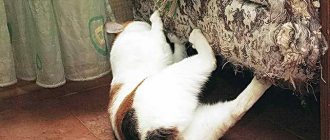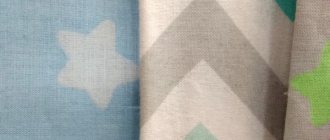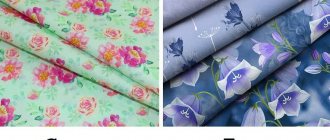Home -Articles -Satin or calico – which is better for bed linen
Today there is a huge amount of bed linen on the market of different textures, colors and sizes. Consumer preferences also vary. Comfort is important to some, practicality or presentable appearance to others. To make the choice easier for customers, we suggest figuring out which is better: satin or calico for bed linen.
Let's start with the fact that both of these fabrics are made from 100% natural cotton, so the material is distinguished by the characteristics inherent in natural components. It is environmentally friendly, does not cause allergies, perfectly absorbs moisture, allows air to pass through, allowing the skin to breathe. To understand what is better - calico or satin - it is necessary to dwell in more detail on the characteristics of the fabric, advantages and disadvantages.
Advantages and disadvantages
When choosing products made from satin and calico, they are easy to distinguish from each other. Satin fabric has a glossy sheen, calico has a matte finish. In addition to significant advantages, these fabric options have their drawbacks, albeit minor ones.
Calico has no shine, which does not make the fabric visually attractive. Over time, pellets appear on the surface of the material, which are very difficult to remove.
Features of satin
Satin has indirect disadvantages - high cost, the fabric can be quite slippery and therefore does not combine well with silk.
Calico and its characteristics
Calico is a fabric consisting of 100% cotton. This textile option has the following characteristics:
- Folds in the fabric can be easily smoothed out without the use of steamers.
- The texture is dense and the texture is pleasant to the touch.
- The cost of the fabric is low.
- The textile has a matte surface without reflection or gloss.
- An additional advantage is the variety of colors and prints.
Calico bed linen set
The creation technology is characterized by a simple process when thick cotton fibers are woven together.
Satin material - features
Satin fabrics are made by specially twisting the fibers and laying them crosswise in an elongated manner.
Note! Thanks to the manufacturing technology, the distinctive feature is a smooth shine on the front side and a knotty roughness on the back.
Additional material features:
- High degree of hygroscopicity - the canvas perfectly absorbs moisture.
- Low level of thermal conductivity. The canvas perfectly maintains the set temperature at any time of the year.
- The texture is soft and the fabric is thin, so this option is ideal for making children's clothing.
- The products retain good external characteristics up to 250 washes.
- The canvas practically does not wrinkle, which makes it possible to use textiles for drapery.
You might be interested in Description of the characteristics of bouclé fabric: use for coats
Important! The material does not cause allergic reactions or irritation if the satin is made from natural fibers.
Satin bed linen
The synthetic version of satin can cause overheating of the body, all other characteristics will be partially or completely modified.
Which is better?
If you are offered to buy a set of satin lingerie for 1000 rubles, then most likely it will not be of good quality. Therefore, if you choose between satin for 1000 and calico for 1500, then, of course, calico will be of better quality.
But in general, it is impossible to say for sure which is better in terms of quality characteristics - both calico and satin have their advantages and you need to choose solely according to your personal preferences.
At the same time, it is believed that satin is a more presentable fabric.
What fabrics are used to make bed linen?
Various textile options are currently used to make bed linen, but calico or satin remains the standard option.
Additional Information! Satin is the most expensive representative of cotton fabrics.
Only these 2 fabric options allow air to pass through well, absorb moisture, wrinkle slightly and are completely environmentally friendly. In addition, the color and shape are retained for a long time after many washes.
Optimal fabric density for bed linen
Each bedding set made of satin or calico will have individual characteristics. Density is considered the main one. According to the standard, the fabric can have from 85 to 130 threads - this is the best option. To strengthen thin fabric, mercerization or calendering is used. Depending on the type of fabric, density 85-170 may occur. Jacquard versions of fabrics can have more than 220 fibers.
Features of caring for satin linen
Calico linen
Calico linen is popular in many countries. The reason for this is the following features:
- Thanks to its natural composition, it allows air to pass through, allowing the skin to breathe freely.
- The material perfectly absorbs moisture, including sweat.
- Cotton prevents the generation and retention of static electricity.
- It washes great. Does not lose color and shape even after repeated washing. Normally, a calico product can be washed more than 100 times without losing its aesthetic appearance.
- The products do not accumulate bacteria - the distance between the fibers allows microorganisms to be removed during the washing process.
Diversity of calico fabric
There are many colors of fabrics.
Types of polysatin
The material is divided into two main types according to the raw material base and application.
- Industrial - 100% polyester, intended for sewing awnings, bags, mattresses, rugs, furniture upholstery, etc. Synthetics do not lose shape or color, do not wear out, and wash well. The smooth, dense surface does not absorb dirt, but repels it, which simplifies maintenance. Although bed linen is also made from such polysatin, few people are impressed by it.
- Household - mixed fabric, usually the proportions of cotton and synthetics are 50/50 or 35/65, but other compositions are also found. Used for sewing casual clothes and bedding sets. Recently, at the peak of demand for beds made of polysatin with a 3D effect, this is the technology of photographic application of bright patterns. The image turns out voluminous and natural, very beautiful sets for every taste. Well, the fact that after numerous washes the linen is as good as new only adds to the number of fans.
The main advantages of polysatin 3D linen are its beauty and ease of care, it does not need to be ironed. Regarding the sensations, some people like that the fabric is cold and slippery, others consider this a minus.
To avoid disappointment, choose a polysatin blend that contains a fairly large proportion of cotton.
The right pillow for a stomach sleeper is different from a pillow for a back sleeper.
You can see the approximate price for a coconut mattress for a newborn here.
How to choose satin underwear
To make the right choice of bed linen, you should pay attention to the following details:
- Pay attention to the composition of the fabric. Only cotton should be present.
- The optimal density should be 120 threads per 1 cm². Density may be indicated in grams.
- It is advisable to choose fabric with mercerization. This treatment makes the color more resistant to fading.
- The sheet, duvet cover and pillowcases should be as smooth as possible; if there are roughnesses on the surface, the fabric will quickly roll up.
You might be interested in this Comparison of Alcantara, eco-leather and velor for a car
Bed linen is often used in classic interiors
The remaining features of the choice are standard when purchasing bed linen - selecting the preferred color and size, checking the quality of the seams.
Opinions are divided
Reviews about satin are mixed, some praise it and recommend it to everyone, others don’t like it at all, but these are in the minority. Still, the affordable price forces many to come to terms with some shortcomings.
I bought a polysatin bedding set, the composition is 100% polyester, but I didn’t find anything good. It’s unpleasant to sleep, it’s electrifying, and then pellets appeared. I won’t fall for the cheap stuff anymore, it’s better to overpay.
I have polysatin underwear with 3D graphics, it looks amazing, doesn’t wrinkle, doesn’t fade, doesn’t shrink. It is very convenient that it dries quickly and does not need to be ironed, this is a real plus for a bachelor. The composition stated that 65% synthetics and 35% cotton, possibly thanks to a natural additive, there is no irritation or static. I'm happy.
In the kitchen there is a beautiful polysatin tablecloth, bright colors and curtains. We have been using it for several years now, the paints are like new, no shrinkage, the surface is smooth. There are no complaints about the quality of the fabric, and the set was quite cheap.
When choosing polysatin, you should pay attention to its composition; if it is pure synthetic, it will be used for curtains, bags and cases. But polysatin with cotton, especially if it is cut in half, is pleasant to the body, beautiful, and durable.
Read reviews about bed linen from the Ivselen company in this material.
Differences between fabrics
The difference between satin and calico is not striking, since both textile options belong to cotton varieties of textiles. But still there are several points of diverse characteristics that can influence the choice.
Softness
Calico is a dense but soft fabric. There are no knots or rough transitions of fibers on the canvas. The material is pleasant to the touch. This is a striking difference between tissues. Satin on the reverse side is rougher and slightly knotty to the touch. From the front it is smooth and slightly slippery. Some types feel like silk, while others are stiff like burlap.
Wear resistance
If the calico quality is good, then the fabric can withstand about 100 washes without changing its appearance.
Note! After 200 procedures, the color will become dull, pellets will appear, but the base will remain strong.
Roll of fabric
Satin can easily withstand more than 300 washes, and only then changes in color may appear. After 400 washes, a change in texture will begin to occur, but use can continue.
Density
Calico has a density that can range from 50 to 130 g/cm². The thinner the thread and the higher the density, the more expensive the cut will be.
Note! The difference in the density of different types of satin is striking. The thinnest fabric can have a density of 50 g/cm², and the jacquard type can have a density of more than 220 g/cm².
Price
The price will also differ. Satin is much more expensive than calico. The difference is due to fabric manufacturing technologies. The cost of the first starts from 80 rub./m², and calico - from 38 rub./m².*
How to care for satin linen?
There are several recommendations regarding the steam care of satin linen, which will help preserve the attractive appearance of the material for a long time:
- The first and all subsequent washes are carried out at a temperature not exceeding 40 degrees. It is advisable to use the “cotton” mode.
- Before placing fabric items in the washing machine, you need to turn the items inside out and straighten the seams.
Additional Information! It is not advisable to fill the drum too much so that the fabric is washed well and the powder is rinsed out thoroughly.
- Before hanging laundry to dry, you need to thoroughly shake each item - this will minimize the degree of wrinkling.
- You can iron the fabric at a maximum iron temperature of 90 degrees.
You might be interested in Description of regiline: areas of use of the tape
Seeing the weave
Note! When performing any procedure - ironing, washing, it is recommended to turn the products inside out so that the color palette is preserved longer and the seams are cleaned.
Areas of use
This woven material has the following applications:
- The first and most important thing for which this material is used is sewing bed linen.
- The second way to use it is on clothing. Most often, women's dresses and blouses, and shirts for men are made from satin. But here they use more expensive and high-quality fabrics. Coarser and less finely crafted materials are used for linings.
Beautiful dresses, shirts, and blouses are made from this material.
Another little-known area is suspended ceilings. If they are made of satin, they take on a rather expensive and elegant look.
Ceilings made of this material look beautiful and elegant.
In addition, a wide range of colors allows you to choose the right solution in each specific case.
For the ceiling, you can choose any color of satin.
You can also realize both matte and glossy surfaces. Satin also allows you to create any pattern or ornament on a stretch ceiling, regardless of the theme.
Any pattern can be depicted on a satin ceiling.
